Lay Apostolates
If the faith dimension of a parish can be
ascertained by the involvement of its parishioners, then
Newry parish is a vibrant, living parish which is reflected
in the dedicated, committed involvement of so many of the
laity in every aspect of parish life.
One of many associations which have
exercised an enormous influence on the life of the parish
was The Holy Family Confraternity, now defunct. This
Confraternity, established in 1874 and comprising circa
2,200 men and boys, was founded as a direct consequence of a
four-week mission, preached by the Passionist Fathers. It
had a very profound influence on the spiritual welfare of
the parish community as well as forming the original
Catholic Working Men's Reading Room and conducting a night
school, musical and literary entertainments and lectures.
Another very important association in the
life of the parish, which has been renewed in recent years
by the students of St. Joseph's High School, was the Pioneer
Total Abstinence Association. At the invitation of Most Rev.
Dr. Michael Blake, Fr. Theobald Mathew visited Newry in
August 1840. He addressed the people in Hyde Market and
formed a Temperance Society where 5,000, including some
non-Catholics, took the pledge. In 1901, some parishioners
obtained permission from Fr. Carlin Adm., to set up a centre
of the Pioneer Total Abstinence Association of the Sacred
Heart. By 1912, 3,000 Pioneers attended the mission
conducted by the Jesuits. The P.T.A.A. had a tremendous
impact on parish life and, under the direction of Fr.
McGrath C.C., it inaugurated the annual pilgrimage to the
Mass Rock in Ballyholland in 1918.
Accord, set up as the Catholic Marriage Advisory
Council by Most Rev. Dr. Eugene O'Doherty on the 9th.
May 1967, is composed of trained Counsellors who work in
a voluntary capacity.
Accord offers pre-marriage courses,
post-marriage support courses, relationship counselling for
couples and individuals, and fertility advice;
- The Legion of Mary, established in Newry on the6th.
September 1932.
- The Knights of St. Columbanus.
- The Society of St. Vincent de Paul.
- St. Joseph's Young Priests' Society.
- The Orana Family Support Centre.
- The Diocesan Youth Commission.
- The Newry and District Lourdes Invalid Fund.
- The Mercy Mission Group, based in the Convent of
Mercy, Catherine Street.
- The Apostolic Workers, situated in St. Mary's Hall,
Boat Street and St. Brigid's Upper Sacristy.
- The Baptism Team which welcomes parents and their
new baby into the parish community.
- The Bereavement Support Group, based in the
Cathedral Chapter Rooms.
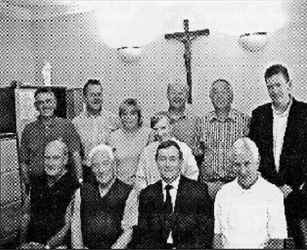
The St. Joseph's Conference of the
Society of St. Vincent de Paul is one of two
branches of the Society within Newry Parish.
Members of the Conference are pictured here
at their premises in Mill Street.

- The Open Door, situated in 39, The Mall, which
offers a listening ear, confidentiality and a friend on
one's journey to everyone.
- St. Mary's Youth Club, situated in St. Mary's Hall,
Boat Street.
- The Catholic Girl Guides.
- The St. John Bosco Youth Club, one of the oldest
youth clubs in Ireland. Their present premises were
blessed by Most Rev. Dr. Eugene O'Doherty on Monday,
15th. October 1973. A plaque to mark the opening was
unveiled by Mr. Pat Jennings, the Irish International
Soccer Goalkeeper.
- The Cathedral Bookshop.
- St. Brigid's Repository.
- The Parish Core Group, established in 1999.
- The Parish Finance Council.
- The Offertory Committee who manage the Offertory
Collections.
- Bethany House Prayer Group, founded in 1976.
- Blessed Edmund Rice Group who gather to celebrate
Mass in the Christian Brothers' Monastery, to pray for
the canonisation of Blessed Edmund and to venerate his
relic.
- Dominican Laity (Third Order).
- Secular Franciscans who are part of the Franciscan
family and are required to pray a daily Office.
- St. Brigid's Prayer Group.
- St. Catherine's Bible Study Group.
- St. Catherine's Rosary Confraternity.
- St. Clare's Prayer Group who meet in St. Clare's
Convent.
- The Newry Branch of the Irish School of Ecumenics.
- The Lectio Divina Group.
- The Perpetual Eucharistic Adoration Group.
- The Purgatorian Society who meet in St. Mary's
Church, Chapel Street, to pray for the faithful departed
by reciting the Divine Office for the Dead.
- The Little Flower Prayer Group which meets in St.
Catherine's Priory and strives to make Jesus alive and
tangible for young people.
- The Dromore Prayer Ministry.
- The Relaxation through Meditation Group.
- The Falcon Club.
- St. Colman's Indoor Bowling Club.
- St. Martin's Twilight Club which meets in Dominican
Hall and provides a social meeting place for the elderly
and lonely.
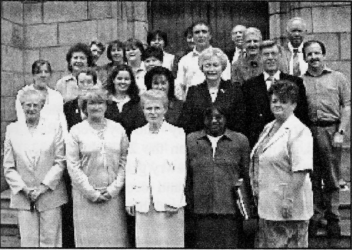
Newry has a great tradition of
choral music, sacred and secular. Members of the
Cathedra! Senior Choir (above), and Junior Choir
(below), are pictured after their respective
Masses on Pentecost Sunday, May 2004.
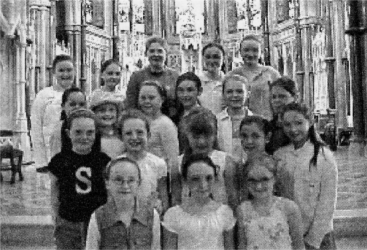

RELIGIOUS
CONGREGATIONS
The Christian Brothers
The Christian Brothers and first-class
education are synonymous in the parish of Newry. Their
arrival in Newry was at the request of Most Rev. Dr. Michael
Blake, who, having seen at first-hand the work of the
Brothers in Dublin and witnessing the appalling poverty
around him in Newry, asked them to open a house in the town.
Consequently, on the 2nd. February 1851, Brother Peter
Scannell and Brother Vincent McDonnell arrived in Newry
where they stayed with Mr. James Grant until they took over
a house and school at the top of Chapel Street, opposite St.
Mary's Church. Before long, the school was full of ragged
bare-footed boys being taught the rudiments of learning and
being prepared for the Sacraments. Dr. Blake provided up to
a hundred breakfasts daily in the Cathedral Sacristy for the
poorest of the boys. He also provided a suit of clothes and
a dinner for them on Easter Sunday.
As the number of pupils increased, other
Brothers joined the small community. The school became
overcrowded and Mr. Felix O'Hagan purchased a site in
Margaret Street on which a school `of considerable
architectural beauty' - later called "The Carstands" - was
completed in 1865. As this premises became inadequate for
the increasing numbers, two classes were accommodated in the
old Home Rule Hall - later known as St. Colman's Hall - in
Castle Street and an old Wesleyan Church in Kilmorey Street
was transformed into a school.
Poverty remained a severe problem and the
Annals record that in 1910 "about 140 of our school boys are
daily provided with a hot meal of soup, potatoes and bread
in St. Colman's Hall". The main sources of income for the
Brothers at this time were the annual bazaar, the annual
concert and the annual sermon, preached in the Cathedral.
The Brothers then purchased the house
next door at Abbey Yard for �700 which was blessed and
opened by Dr. Mulhern on the 25th. November 1918. This, in
time, also served as the Abbey Grammar School.
When the Primary and Grammar Schools
moved to their respective new premises in 1938 and 1966
respectively, the Brothers, true to their commitment to the
disadvantaged and to the people of Newry, gave over their
site in Castle Street and Abbey Yard and, in June 1971, went
to live in their monastery behind the Grammar School. The
old site was renovated and now functions as a Conference
Centre and a training centre and houses community workshops.
The work of the Christian Brothers for
the people of Newry - and elsewhere - cannot be overstated.
Though reduced in numbers here in Newry, they continue to
work in a quiet, committed way for the people of God and
their monastery remains a beacon of hope for Newry
parishioners.
Dominican Fathers
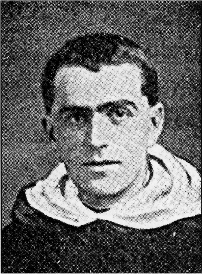
Fr. J.B. Williard O.P.
(above), was Newry's first Dominican
prior (1871- 74). He was succeeded by
Fr. Alphonsus O'Callaghan (below),
(18741877). The Dominican Fathers
minstered originally at St. Mary's
Church, Chapel Street, until the opening
of their own Church in the autumn of
1875.
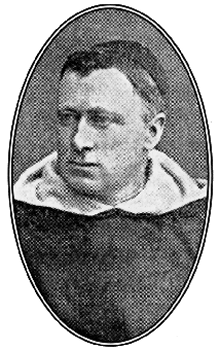
The Dominican association with Newry
Parish has been a long and fruitful experience for both the
parishioners and the Dominican community.

In May 1870, four members of the Order of
Preachers were invited by Most Rev. Dr. John Pius Leahy O.P.
to conduct a month-long mission for the parishioners of
Newry. As a result of this experience, a deputation of the
parishioners asked Dr. Leahy to establish a Dominican
foundation in the town. The latter refused their request at
first because the people were very poor and he thought that
they would be unable to support both the priests of the
parish and the Dominicans. However, the people were
determined to achieve their objective and after a decent
lapse of time, approached the Bishop again, guaranteeing
support of the new religious house.
Accordingly, on Tuesday 7th. March 1871,
three Dominican Fathers and a lay Brother arrived in Newry.
They took up residence temporarily in a "commodious house"
in McAllister's Terrace, Hyde Market where a three-month
tenancy had been obtained until a house in Upper Chapel
Street - The Hermitage - was ready. They remained in this
latter house, renaming it "Priory House", until St.
Catherine's Priory was built. Two weeks after their arrival,
on Sunday 23rd. March 1871, they took over St. Mary's Church
where they ministered until their new Church was opened in
1875. On the 5th. November 1871, a charity sermon, delivered
by Rev. C.H. Conlon, was preached in St. Mary's Church and a
group of Newry ladies organised a bazaar in January 1872 to
float the Building Fund.
A discussion then ensued as to whether
the Church should be built in Ballybot or on the north side.
This was settled when Mr. John Quinn offered the Fathers a
quarry field at an annual rate of �20. Messrs. Ashlin and
Co., Dublin, were commissioned as architects. In Autumn
1875, when the Church was completed, two houses adjoining
the property were rented. Then, the Dominicans said goodbye
to St. Mary's Church and Priory House and moved to Queen
Street (now Dominic Street) on the 5th. October 1875.
On the 14th. May 1881, the foundation
stone of the new Priory was solemnly laid by Very Rev. Fr.
Towers, Provincial, and on the 28th. July 1882, the
three-storey building in Newry granite, built by Mr. J.
Lennon, was completed and occupied for the first time. The
debt was cleared by a five-day bazaar, organised by the
townspeople, which realised �2,300. Since then, the
Dominican community has continued to give unstinted and
committed service to the people of Newry, caring for their
spiritual needs, visiting the sick and bereaved, organising
events for young and old alike, encouraging lay
participation, providing courses on Scripture and promoting
Gospel values as they go their way in a quiet, unobtrusive
manner.

The Sisters of St. John of God
The Sisters of St. John of God came to
Newry in 1904 at the invitation of Most Rev. Dr. Henry
O'Neill to take charge of Daisy Hill Infirmary, which
replaced the Newry Workhouse.
Then, on the 3rd. September 1945, the
Sisters purchased Courtenay Hill House from Richard Henry
McAreavey for �2,000. Although originally
intended as a house for the Sisters working in Daisy Hill
Infirmary, the needs of the people of Newry compelled the
Sisters to convert this house into a Nursing Home for the
elderly which was undertaken at a cost of �4,193.18.7. The
Nursing Home consisted of a basement, ground floor and first
floor and provided facilities for twenty two patients. The
first patients were admitted early in 1946. By 1949, the
number had risen greatly.
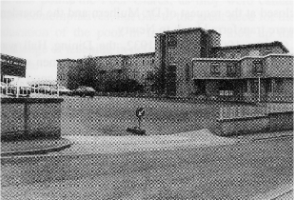
The hospital of the Sisters of St.
John of God, opened at Courtenay Hill on
30th. March 1967. Today it accommodates
St. John's House - the Southern Area
Hospice.
In 1946 also, the Sisters went to work in
St. Colman's College, Newry where they remained for several
years.
Since the biggest demand in the Nursing
Home was for surgical facilities, it was decided to provide
this service and also that the existing building, which had
begun to deteriorate gradually, would be replaced. This was
done at a cost of �200,000 - �28,000 of which was donated by
friends and former patients. This fine hospital was opened
on the 30th. March 1967, providing medical, surgical and
maternity services, with accommodation for forty seven
patients. In the mid seventies, the theatre and annexes with
Admission and Out-Patient Departments were incorporated. An
agreement was reached with the Daisy Hill Hospital
administration to provide six beds on a `contracted out'
basis which was reviewed annually. This agreement was
terminated in the late 1980s.
In December 1980, the Sisters finally got
their Convent adjoining the Nursing Home on the site of what
was, originally, St. Colman's College. At this juncture, the
Sisters working in Daisy Hill Hospital joined the Courtenay
Hill community. In July 2000, the last Sister working in
Daisy Hill Hospital retired. A new initiative was begun in
September 1989 when the Sisters, in partnership with the
Southern Area Health Board, established the Newry and Mourne
Hospice, a six-bedded unit which was to provide care
for the terminally ill, for which neither
patients nor relatives were to be charged. The Hospice was
blessed by Most Rev. Dr. F.G. Brooks and opened by Mr.
Patrick Manson, Chairman of the Southern Health and Social
Services Board. The cost of running the Hospice service was
to be met by Southern Health and Social Services Board
grants and by fund-raising activities. The Hospice has
continued to expand and, since 1999, has become known as St.
John's House - the Southern Area Hospice.
And so the work of the Sisters goes on in
a quiet, dedicated manner, changing focus as the need
arises, but always showing the compassion of God to those
most in need.

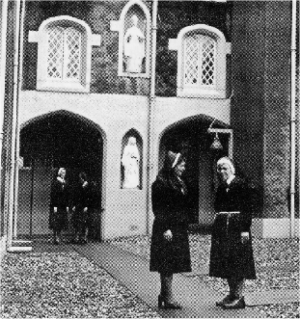
Reputed to be the first religious
order to establish themselves north of the River
Boyne after Catholic Emancipation, the Sisters of
St. Clare have maintained a convent at High Street
(above) since 1830. Twenty-five years later the
first group of Mercy Sisters arrived to Canal
Street. They went on to build a large convent in
Catherine Street (below), in 1862.
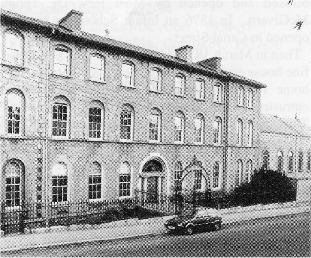
The Sisters of Mercy
The story of the Sisters of Mercy in
Newry began on the 26th. June 1855 when, at the invitation
of Most Rev. Dr. Michael Blake, five Sisters arrived from
the Convent of Mercy, Kinsale, to make a foundation there.
They took up residence in Ogle's Big House in Canal Street,
which had been purchased as a temporary Convent from funds
collected in Newry.

The first work of the Sisters was the
establishment of the House of Mercy. This was quickly
followed by the opening of a public laundry in 1855 to train
young girls and to provide them with a means of support. The
Sewing School was then established where a great number of
girls were taught to earn their living by needlework, plain
sewing, embroidery, fancy work and Limerick lace. This
School achieved world-wide renown, winning many prizes and
receiving orders from wealthy clients from as far away as
Australia.
In 1858, the Sisters opened an orphanage
in Canal Street, housing twelve children. When the Sisters
moved to the Catherine Street Convent on the 8th October
1862, Ogle's Big House was developed as a House of Mercy and
Orphanage.
On the 9th. June 1865, four Sisters from
Newry founded a Convent in Rostrevor, which was followed on
the 20th. August 1866 by a foundation in Lurgan. In May
1867, the Sisters got permission to make regular visitation
in the Newry Workhouse and between 1902 and 1904, three
Sisters worked there.
The National School was opened in Canal
Street on the 24th. May 1869. Then in 1872, Dr. Leahy
"wishing that the respectable Catholics of the town should
have no pretext for sending their children to the Model
School" (Annals) asked Mother Emmanuel Russell to open a
school for the better-off, charging the same fees as the
Model School. This request was granted on the 21st. November
1887 and thus began the new Intermediate School, later to
become known as Our Lady's Grammar School, with a tuition
fee of fifteen shillings per quarter. The new building which
adjoined the National School in Canal Street was blessed and
opened by Most Rev. Dr. Thomas McGivern. In 1876 an Infant
School for boys was opened in Canal Street.
Then in March 1879, Mr.Thomas Fegan
purchased a fine house and garden in Kilmorey Street to
provide a home for needy respectable people and this was
entrusted to the Sisters on the 27th. August 1879. Thus,
many old ladies were spared the indignity of having to go to
the Workhouse.
On the 27th. November 1888, six Sisters
from Newry formed a community in Warrenpoint and established
a National School there.
Due to the munificence of the Russell
Family, the Emmanuel Chapel in the Catherine Street Convent
was built. The foundation stone was laid on the 9th. July
1902 by Most Rev. Dr. Henry O'Neill and blessed and opened
by him on the 20th. July 1904. At the request of Most Rev.
Dr. Edward Mulhern, a boarding school was opened in Newry on
the 6th. September 1918. This project flourished and on the
16th. February 1923, the community in Newry got permission
from Rome to take possession of the Great Northern Hotel in
Warrenpoint as a boarding school. The boarders moved there
on the 28th. June 1923. However, in June 1930, the boarding
school was closed at the request of Dr. Mulhern and the
boarders were transferred back to Newry.
On the 10th. October 1932, the Dining
Hall was opened to supply the poor men and women of the town
who were starving with at least one good meal in the day,
which, owing to the lack of employment, they could not
procure otherwise. The numbers ran into hundreds.
Most Rev. Dr. Edward Mulhern blessed and
opened the new Elementary School in Edward Street on the
27th. October 1927.
On the 15th. August 1961, five Sisters from Newry founded
a Convent in Mobile, Alabama and on the 5th. September 1961,
opened St. Dominic's School with an enrolment of 262 pupils
which grew to 622 by 1971. The Sisters also instructed
converts and visited the prison. One Sister also served as
Curriculum CoOrdinator of the Diocesan Office of Education
from 1976-1978 and, later, as Superintendent of Schools. In
1987, a Sister went to Minna, Nigeria, where she worked as a
co-ordinator of women's development projects such as rural
development, literacy and primary health care. When she
returned to Newry in 1996, she was replaced by a Sister who
has been training native Africans in primary education in
order to improve their chances of combating poverty. She 4
has built a school - one room each year and is confident
that her `trained staff' will be able to continue the work
when she returns home.
The Sisters nowadays continue their work in various
apostolates, each in her Own way trying to make Christ's
love for humanity real, and to meet the changing needs and
challenges of today's world: caring for the elderly in
Homes, visiting the lonely, sick and house-bound, offering
counselling services. Some liaise with the laity in groups
such as St. Vincent de Paul, Simon Community, Mercy Mission
Group and Cuan Mhuire. Orana House, now closeds as a
Children's Home, has become a vibrant Family Support Centre,
catering for all sections of society and providing a wide
range of services, in conjunction with the government-funded
Sure Start Project, to support families. Those victimised
and marginalised by society as well as the poor are a matter
of concern a to the Sisters of Mercy, who strive to
strengthen and deepen their own relationship with and
commitment to Christ and to joyfully and compassionately
share that relationship with others in this modern,
ever-changing technological world.

Sisters of St. Clare
In an attempt to alleviate the widespread
poverty and misery around Newry and to meet the dire need
for Catholic education, Most Rev. Dr. Kelly invited the
Sisters of St. Clare to found a convent in Newry. At this
point, the Poor Clares, as they were called, were
contemplatives, but due to the great need for the education
of the poor in Ireland, they took up the challenge of
teaching in deference to the wishes of the Church.
Accordingly, on the 2nd. June 1830,
Mother M. Michael Tracey and four other Sisters arrived by
stage-coach to Newry. A house was purchased in High Street
between an Orange Lodge and a Unitarian Conventicle and
graveyard and, although they experienced some opposition at
first, it was not long until they were fully accepted. On
the 12th. August 1830, the foundation stone of the Chapel
and schools was laid and on the 4th. October 1830, the first
postulant, Miss Rice, entered the Convent.
By May 1831, there were 400 children
attending the school and by 1835, this number had increased
to 500, including a number of orphans. In 1832, The Newry
Telegraph paid a glowing tribute to the Sisters "for
their instruction of poor female children in the ways of
virtue and for their rescuing the orphan".
In 1840, a workroom was opened in which
embroidery and lace-making were taught which provided a
means of livelihood for the girls. "In the workroom, not
only were the girls trained in an art which became for some
a help, for many a means of livelihood for themselves and
their families, but under the fostering care of the nuns,
the girls were grounded in solid Christian piety and
virtue". When the Sisters of Mercy came to Newry in 1855,
they took over the lace-making. In 1848, a kitchen was built
in which 150 children were given a meal daily.
On the 5th. September 1857 a charity
sermon "specially for the purpose of an Infirmary for
dispensing medicines to poor children and for an infant
school" realised �140. On the 19th. July 1880, the first
stone of the Lecture Room and Children's Hall was laid. The
Sisters taught in the original school until a larger one was
built in 1866, when the former was converted into a Convent.
By the 2nd. June 1880, the Sisters had altered, built,
improved and remodelled the earlier buildings.
At the request of parents, a school for
boys was opened in 1891 and a lending library made books
available for the people. A two-storey Boys' Infant School
was opened on the 23rd. October 1894.
A knitting industry was started in 1924
to help combat the widespread poverty in the area, caused by
unemployment. A Secondary School followed in 1930 and this
was followed in 1938 by a foundation in Porthcawl in South
Wales.
Thus, we have in Newry a community which
has, since its establishment, worked for the good of Newry
parishioners, adapting its focus and emphasis to cater for
their changing needs, but always committed to serving God
and His people.
Sisters of Charity of Nevers
The Sisters of Nevers, founded in 1680 by
Jean-Baptiste Delaveyne, a Benedictine monk, came to Newry
in 1993. The mission of the Order is to show that God loves
all humanity with an inestimable love. To fulfil this
mission, each Sister is called "to have no other concern
except that of love and no other interest except for the
excluded". At present, two Sisters live in Ashgrove Park and
are involved in the Newry Hospice, teaching religion in a
local school, visiting and assisting the elderly and working
with Women's Aid, thus living out the mission of the
Congregation.

CLERGY OF NEWRY PARISH
|
Parish Priests |
| Rev.
Dominick Mac Ilboy, (Mac Evoy) |
1704 |
| Rev.
James Mac Key, |
1782 |
| Rev.
Bernard Devlin, |
1793 |
|
Administrators |
| Rev.
Thomas Cranny, |
1793 |
| Rev.
Patrick Mac Cartan, |
1877 |
| Rev.
Michael McConville, |
1887-88 |
| Rev.
Thomas Gallery, |
1888-91 |
| Rev.
James Carlin, |
1891-1906 |
| Rev.
John Rooney, |
1906-07 |
| Rev.
Joseph Doyle, |
1907-14 |
| Rev.
Daniel Grant, |
1914-23 |
| Rev.
Francis J. O'Hare, |
1923-23 |
| Rev.
James Fitzpatrick, |
1923-32 |
| Rev.
John Magee, |
1932-34 |
| Rev.
Edward James Mac Ateer , |
1934-37 |
| Rev.
Patrick Francis Mac Comiskey, |
1937-50 |
| Rev.
Edward Campbell, |
1950-55 |
| Rev.
James Boyd, |
1955-57 |
| Rev.
James Burke, |
1957-60 |
| Rev.
Hugh Esler, |
1960-61 |
| Rev.
Jack Lynch, |
1961-70 |
| Rev.
Edward Hamill, |
1970-81 |
| Rev.
Arthur Byrne, |
1981-87 |
| Rev.
Arthur Bradley |
1987-92 |
| Rev.
John Kearney, |
1992-98 |
| Rev.
Aidan Hamill, |
1998-2003 |
| Rev.
Terence Rafferty, |
2003 - ad
nunc |
Priors of the Dominican Community
| Rev. J.B. Williard,
|
1871-1874 |
| Rev. Thomas Alphonsus
O'Callaghan, |
1874-1877 |
| Rev. Augustine Coveny,
|
1877-1880 |
| Rev. T.A. O'Callaghan,
(second term), |
February -
August 1880 |
| Rev. Patrick Vincent
Flood, |
1880-1883 |
| Rev. Thomas Purcell,
|
1883-1886 |
| Rev. J.C. Lyons, 1 |
886-1892 |
| Rev. M.A. Hughes, |
1892-1895 |
| Rev. M.A. Duhig, |
1895-1897 |
| Rev. D.B. Falvey, |
1897-1907 |
| Rev. M.J. Moore, |
1907-1912 |
| Rev. D.B. Falvey, |
1912-1914 |
| Rev. S.A. O'Kelly, |
February -
December 1914 |
| Rev. D.P. Magennis,
|
1915-1918 |
| Rev. B.A. Murphy, |
1918-1921 |
| Rev. C.P. O'Sullivan,
|
1921-1924 |
| Rev. E.H. Collins, |
1924-1930 |
| Rev. D.M. Fahy, |
1930-1933 |
| Rev. P.J. O'Hara, |
1933-1939 |
| Rev. Joseph Powell,
|
1939-1942 |
| Rev. Aengus Byrne, |
1942-1948 |
| Rev. Paul Flanagan,
|
1948-1951 |
| Rev. Michael Pius.
Clery, Ph.D. |
1951-1957 |
| Rev. P.J. Long, |
1957 -1960 |
| Rev. Norbert Barry,
|
1960-1963 |
| Rev. Edmund Walls, |
1963-1969 |
| Rev. John O'Rourke,
|
1969-1978 |
| Rev. Raymond Collins,
|
1978-July
1984 |
| Rev. Augustine Doherty,
|
1984-1990 |
| Rev. Benedict Hegarty,
|
1990-1996 |
| Rev. Terence
McLoughlin, |
1996-1999 |
| Rev. Anthony McMullan,
|
1999 - ad
nunc |

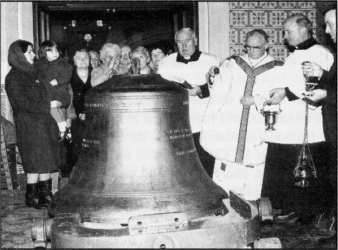 |
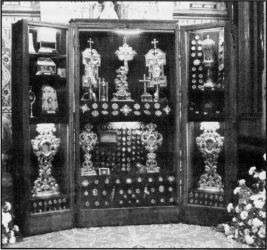 |
|
The Cathedral bell, `Colman', was
originally cast by the Sheridan foundry, Dublin,
in 1862. Here it is being re-dedicated by Bishop
Brooks after it was re-cast in 1987. |
This impressive reliquary was presented on the
occasion of the Cathedral's consecration, in
1925. It contains over two hundred relics and is
displayed every year, in Our Lady's side-chapel,
on the Feast of All Saints. |
CONCLUSION
The parish of Newry, therefore, can boast
of a long tradition of endurance under persecution and
difficulties, and loyalty to its faith and pastors. The
parish has been very fortunate in its leadership down
through the centuries whose perception and intuition
overcame many daunting challenges and who endeavoured to
lead the parish community through some very difficult times.
It can be justly proud also of the loyalty and commitment of
the parishioners who stood steadfast in time of persecution
and remained loyal to the tenets of their faith and diligent
in promoting spiritual, social and gospel values, at all
times maintaining the dignity of each person. These values
are still inherent in all areas of parish life and are
implicit in all parish activities. Thus, the parish of
Newry, though greatly increased numerically, remains in the
twenty-first century, a vibrant, living parish community
whose faith history continues to unfold in diverse ways.
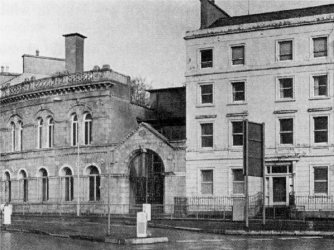
St. Colman's Hall was a popular setting for dances,
concerts and other social occasions in the latter half of
the twentieth century. Previously the property of a local
bottling company, the Trevor Hill Hall was officially opened
by Newry Parish on 16th. September 1959. It was sold in
2003, with the proceeds going towards the building of a new
pastoral centre and the upgrading of existing facilities
closer to the Cathedral.
 |